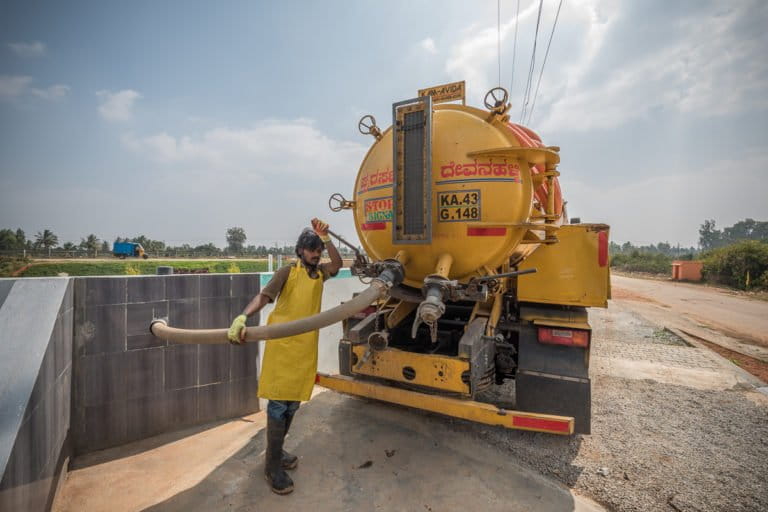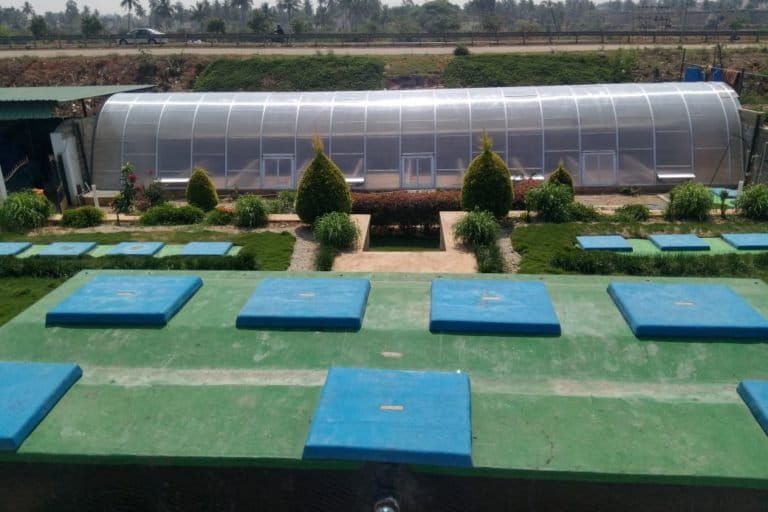- In India a significant amount of sewage goes untreated and flows back into the ecosystem. This can potentially lead to the spread of disease-causing pathogens that are harmful for the environment and public health.
- Sustainable sanitation systems combined with facilities and knowledge to practice good hygiene are a strong defence against COVID-19 and future disease outbreaks. Therefore, there is an urgent need for us to move beyond the toilet and start focusing on treatment of waste.
- Compared to centralised sewerage systems, Faecal Sludge Management is a faster and cost-effective alternative as it aims to fix gaps in the sanitation value chain by tapping into already existing systems and infrastructure, at the local level, in a scientific manner ensuring easy adoption and sustainability over a long term, write the authors of this commentary.
- This post is a commentary. The views expressed are those of the author, not necessarily Mongabay.
It was a proud moment for India when in October 2020, the government announced that close to 99% of Urban Local Bodies (ULBs) and 100% of rural India have achieved Open Defecation Free status. While one cannot deny the fact that India has made massive strides in its effort to provide improved sanitation to its people, there are still many questions around its sustenance and linkage to a complete sanitation solution. Building toilets is one thing, but the country’s real success would lie in achieving (by 2030) the SDGs that link Water and Sanitation as a whole.
While toilets are the first step to curtailing open defecation, building toilets alone does not guarantee safe sanitation. In fact, toilets bring with them a larger set of problems. First, getting people to use them; the second biggest challenge is the safe and scientific management of the faecal waste generated from these toilets. This is a matter of pressing concern, especially for India where 70% of the population relies on onsite sanitation systems, such as septic tanks and pits, faecal waste from which is finding its way (back) into the environment – mainly waterbodies – untreated, nevertheless. This coupled with discharge of other streams of waste (like solid waste and greywater) further compounds the issue of managing existing surface water resources, which have been bearing the brunt of pollution for a long time now.
The issue isn’t about our waste management practices or lack of the same, but about our general attitude towards one of our most valuable life-sustaining resource – water!
With the growing developments in urban centres today, there is huge pressure on natural water resources. As most surface water resources are heavily polluted, people are largely tapping into groundwater, which if not checked (soon) could lead to a grave situation in the near situation.
Read more: Bathing in Ganga during Kumbh may wash away sins, but what about diseases?
In a country facing rapidly worsening water shortages, this is doubly crippling – freshwater sources are becoming polluted and unusable, and wastewater that could be treated and re-used, is being wasted.

What’s really required is taking a step back and relooking at our current water and wastewater management solutions. Experience of numerous large-scale urban sector programs has established that though sewerage systems connected to large centralised treatment system are an apt solution for densely populated areas, they entail numerous challenges –
- huge land and resource requirements for setting up the infrastructure
- long duration of the projects many-a-times leads to unprecedented escalation of costs
- availability of enough water supply for ensuring cleansing velocity
- intense operations and technical expertise in operating and maintaining such systems, and
- readiness amongst citizens to pay for such services.
So, while sewerage systems are an option for large metro cities (given their access to funding), small cities and towns find it challenging to overcome these issues. A 2016 calculation by CDD Society showed that only half of India could have access to adequate sanitation by 2026, if it chose the centralised route. The same budget, if invested entirely on decentralised solutions, could give adequate sanitation to the country as early as 2021.
The solution thus lies in breaking down the issue at a localised level and planning holistic solutions for optimizing both water consumption as well as wastewater treatment.
This is where Faecal Sludge Management (FSM) comes in. Compared to centralised sewerage systems, FSM is a faster and cost-effective alternative as it aims to fix gaps in the sanitation value chain (a tool/framework/approach used to evaluate the benefits of improved sanitation, consisting of five important steps – user interface, collection, emptying, conveyance, treatment and disposal) by tapping into already existing systems and infrastructure, at the local level, in a scientific manner ensuring easy adoption and sustainability over a long term. How FSM was established in Devanahalli through the successful setup of a Faecal Sludge Treatment Plant (FSTP) is a great example of this.
The FSTP at Devanahalli certainly marks a key milestone in India’s sanitation journey. It demonstrated that it is possible to provide sanitation to an entire town in a safe, cost-effective, incremental, and aesthetically appealing manner. Many state Governments have been inspired by the Devanahalli model as the latest available data indicates that more than 100 FSTPs based on a similar model (i.e. of looking at FSM holistically) have been set up and over 200 are under different stages of implementation across the country.

Though so many states are in the initial stages of adopting FSM, it is important to acknowledge that since FSM is a relatively new approach to managing human waste in isolation, it does face numerous challenges – which impact efficient roll out on-the-ground. This is primarily because in order to the successful, FSM solutions need to be contextualized. Unlike wastewater treatment, faecal sludge treatment is largely contingent on suitable treatment sequence in order to comply with existing standards as well as to achieve nutrient recovery.
Today, there are only a handful of organisations from the National Faecal Sludge and Septage Management Alliance (NFSSM) which are into designing and implementing technologies to treat faecal sludge in a scientific manner. The National Faecal Sludge and Septage Management (NFSSM) Alliance was established with support from the Bill and Melinda Gates Foundation in 2016 to support safe sanitation at the national, state and city level. The Alliance is recognized as the collaborative body that drives the discourse of faecal sludge and septage management (FSSM) forward in India.
Further, barring a couple of laboratories capable of testing faecal sludge, there aren’t too many across the country to support further development and innovation on the technology side. The sector has also been witnessing a newfound interest in ‘Reinventing The Toilet (RTI)’ program which encourages research and development in the WASH sector making small scale sanitation systems accessible to the communities that lack access to safely managed sanitation facilities. However, there is still a long distance to be covered in this area.
On the technology side, there aren’t too many options available today. Existing faecal sludge treatment systems can be grouped mainly under passive and thermo-mechanical types. While each technology has its own pros and cons, what really matters in the end is how relevant and user-friendly a selected technology is for a given context. With most administrations opting for low maintenance and easy-to-operate systems, many treatment plants today are designed as passive or nature-based systems. However, to optimize space requirements, some improvements are being tried out in the sector – combining a few mechanized modules to bring down the space and time requirements for achieving required treatment levels. Further, to tackle the issue of pathogens, thermal systems are also being set up in many places.
However, the success of an FSM intervention is not limited to creating well-designed treatment infrastructure only. Being a largely stakeholder led initiative, it requires bringing in different stakeholders into the fold of project planning, right till the operations and monitoring stage. Stakeholders include – the municipality, local desludging operators, public and sanitary workers, amongst others. Further, like any intervention that focuses on creating a positive impact on-the-ground, FSM planning also needs continued efforts on advocacy, sustainability, capacity building, monitoring and regulation. Efforts by BORDA (Bremen Overseas Research and Development Association) and CDD Society in a few small towns like Devanahalli, Leh, Sircilla, and Dhenkannal are examples of simplifying a complex sanitation problem by focussing on sustainable technology solutions which are easier-to-adapt by smaller towns and cities, in the process also ensuring public participation and well-defined operations mechanisms.
It’s also heartening to see how policy is supporting this. Unlike the grand visions of the past urban initiatives, recent policies and schemes being developed by the Governments both at the National and State levels, are slowly turning the needles towards ground realities – with the focus being on solutions which are easy-to-implement and maintain on-the-ground. The recently launched policies around Water and Sanitation across many States rely largely on comprehensive Government-funded schemes like the Swachh Bharat Mission, Jal Jeevan Mission, AMRUT etc. each focusing on sanitation coverage, water conservation and urban transformations respectively.
To sum up, some strides are being made in the sector on different fronts in terms of technology development and formalising an informal sector, which was neglected earlier for many years. However, there are still miles to cover in terms of setting universally acceptable and achievable standards for faecal sludge treatment, creating a menu of technologies for treatment and encouraging innovations in the area of collection and transportation of faecal sludge. There have been some efforts in a few pockets across each of these areas by different organizations and administrations, but unless it is all tied up, real impact may not be visible on ground. Therefore, working in collaboration and fortifying each other’s work is key to sustaining the momentum created by the Swachh Bharat Mission and in ensuring that none of these efforts go down the toilet.
Sandhya Haribal leads one of the teams in the wastewater management sector at CDD Society which is a member of the National Faecal Sludge and Septage Management (NFSSM) Alliance. Tarika Vaswani has been involved in the Water and Sanitation sector for the past four years, through CDD Society, where she leads Communications.
Banner image: Pit emptying at Devanahalli. Photo from CDD Society.
